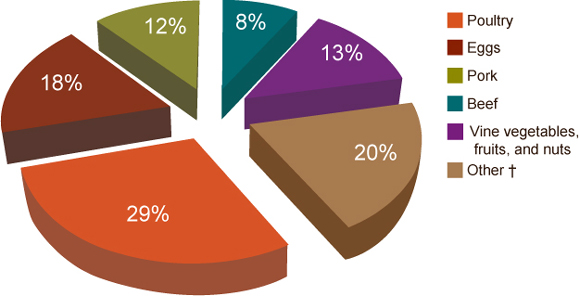Vital Signs: Making Food Safer to Eat
Reducing contamination from the farm to the table
June 2011


 1 in 6
1 in 6
About 1 in 6 (or 48 million) people gets sick each year from contaminated food.
 50%
50%
E. coli O157 infections have been about in half since 1997.
 365 Million
365 Million
Salmonella infection accounts for $365 million in direct medical costs each year.
Each year, roughly 1 in 6 people in the US gets sick from eating contaminated food. The 1,000 or more reported outbreaks that happen each year reveal familiar culprits—Salmonella and other common germs. We know that reducing contamination works. During the past 15 years, a dangerous type of E. coli infection, responsible for the recall of millions of pounds of ground beef, has been cut almost in half. Yet during that same time, Salmonella infection, which causes more hospitalizations and deaths than any other type of germ found in food and $365 million in direct medical costs annually, has not declined. Each year, 1 million people get sick from eating food contaminated with Salmonella. Applying lessons learned from reducing E. coli O157 infections could help reduce illness caused by Salmonella.
Targeting Salmonella
Salmonella infection has not declined in 15 years
Reducing Salmonella infection is difficult because
- It is found in many different types of foods: meats, eggs, fruits, vegetables, and even processed foods such as peanut butter.
- Contamination can occur anywhere: from fields where food is grown to cutting boards in kitchens.
- What we eat and how we eat have changed: foods coming from one central location are widely distributed, meaning that sickness can spread quickly; we eat more meals outside the home; and more foods and ingredients come from all over the world.
- Some policies and procedures that can make a difference in reducing contamination take years to put into place.

*These contaminated ingredients or single foods (belonging to one food category) were associated with 1/3 of the Salmonella outbreaks.
†Other includes: Sprouts, leafy greens, roots, fish, grains-beans, shellfish, oil-sugar, and dairy.
Source: CDC National Outbreak Reporting System, 2004–2008.
Salmonella infection can be reduced by
- Taking strong and specific action to identify and prevent contamination from the farm to the table—a primary lesson learned in successfully reducing E. coli O157 infection.
- Developing new prevention strategies for the riskiest foods before and after harvesting.
- Enhancing laboratory testing and disease reporting to more quickly identify outbreaks and their causes.
- Investigating outbreaks quickly and alerting consumers and industry of concerns to prevent more illness.
- Using prevention-focused safety systems like the Hazard Analysis and Critical Control Point management system and applying technologies (for example, use of high temperatures in pasteurization and cooking) to reduce contamination.
- Putting into action new policies that focus on preventing food safety problems and address new challenges.
Change in E. coli O157 and Salmonella infection, 1996–2010

Source: Foodborne Diseases Active Surveillance Network, 2010.
Work together to reduce Salmonella and other foodborne illnesses
Government can
Implement policies and regulations
- Ensure that food production and service facilities adopt proven preventive measures and enforce food safety laws and regulations, including requirements for eggs, meat, poultry, and processed and imported foods.
- Increase and improve inspections in the US and abroad.
- Develop and implement safety standards for fruits and vegetables.
- Use what is learned from outbreaks, inspections, and monitoring systems to develop new and improve existing prevention strategies.
Track and investigate illness
- Track trends, report progress, and make sure policies aimed at reducing infections work.
- Fund state and community efforts to identify and report sicknesses and catch outbreaks faster.
- Investigate outbreaks thoroughly to identify sources and improve control strategies.
- Develop new tools to find sources of contamination and characterize germs faster.
Farmers, grocery stores, and places that make, sell, or serve food can
- Use good management practices to reduce contamination when raising livestock or food animals.
- Adopt proven preventive measures for food safety plans in all food production and service facilities.
- Follow the US Food and Drug Administration Model Food Code in restaurants and other places that serve food.
- Keep good records of where foods and food ingredients come from.
- Train and certify managers in food safety in all restaurants.
Health care providers can
- Diagnose and treat infections by using best practices and report them rapidly.
- Talk to high-risk patients about food safety.
- Report suspected outbreaks to your local health department.
Everyone can
- Clean. Wash hands, cutting boards, utensils, and countertops.
- Separate. Keep raw meat, poultry, and seafood separate from ready-to-eat foods.
- Cook. Use a food thermometer to ensure that foods are cooked to a safe internal temperature: 145°F for whole meats (allowing the meat to rest for 3 minutes before carving or consuming), 160°F for ground meats, and 165°F for all poultry.
- Chill. Keep your refrigerator below 40°F and refrigerate food that will spoil.
- Report suspected illness from food to your local health department.
- Don’t prepare food for others if you have diarrhea or vomiting.
- Be especially careful preparing food for children, pregnant women, those in poor health, and older adults.
- Visit FoodSafety.gov for the latest information on preventing food poisoning.
- Vital Signs: Morbidity and Mortality Weekly Report (MMWR)
- Multistate Outbreak of Salmonella Infections: Morbidity and Mortality Weekly Report (MMWR)
- Making Food Safer to Eat – What You Need to Know [PODCAST – 01:28 minutes]
- Making Food Safer to Eat – What You Need to Know [PSA – 0:60 seconds]
- Food Safety at CDC
- Global Foodborne Infections Network
- Prevention and Education
- Just for Kids
- CDC – Salmonella is a Sneaky Germ: Seven Tips for Safer Eating
- 24/7 story on the Listeria investigation

